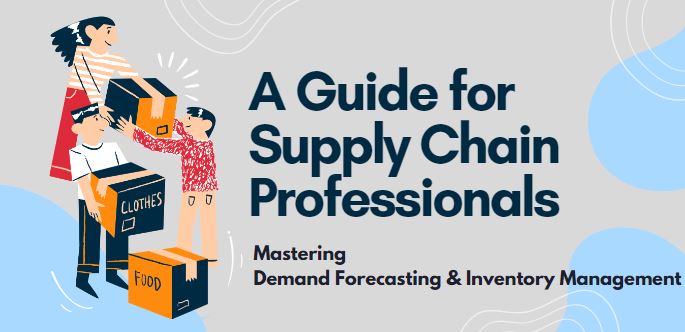
Introduction: The Backbone of Successful Supply Chains
In today’s fast-paced business world, staying ahead of the curve is crucial for success. This is particularly true in supply chain management, specifically in demand forecasting and inventory management. These two interconnected aspects form the backbone of a well-functioning supply chain, enabling businesses to meet customer needs efficiently while minimizing costs and waste.
Understanding these concepts is essential for students and working professionals looking to advance their careers in this field. This is where specialized education, such as an Online PGDM in Supply Chain and Logistics at MITSDE, can provide the knowledge and skills needed to excel in this dynamic industry.
Let’s dive deep into demand forecasting and inventory management, exploring their importance, fundamental techniques, and how they contribute to overall supply chain success.
The Importance of Demand Forecasting
What is Demand Forecasting?
Demand forecasting is the process of predicting future customer demand for a product or service. It involves analyzing historical data, market trends, and other relevant factors to make educated guesses about future sales volumes.
Why is it Critical?
Accurate demand forecasting is crucial for several reasons:
- It helps businesses plan production schedules
- It aids in inventory management and stock control
- It assists in financial planning and budgeting
- It improves customer satisfaction by ensuring product availability
Common Demand Forecasting Techniques
There are several methods used for demand forecasting, including:
Time Series Analysis:
This method uses historical data to identify patterns and trends.
Causal Models:
These models consider external factors influencing demand, such as economic indicators or marketing efforts.
Qualitative Methods:
These involve expert opinions and market research to gauge future demand.
Machine Learning and AI:
Advanced algorithms can process vast amounts of data to make highly accurate predictions.
An Online PGDM in Supply Chain and Logistics at MITSDE can provide in-depth knowledge of these techniques, enabling professionals to choose the most appropriate method for their business needs.
The Art and Science of Inventory Management
Understanding Inventory Management
Inventory management is the process of ordering, storing, and using a company’s inventory. This includes managing raw materials, components, and finished products and warehousing and processing of such items.
Key Objectives of Inventory Management
Effective inventory management aims to:
- Minimize storage costs
- Prevent stockouts and overstocking
- Maintain optimal inventory levels
- Improve cash flow
- Enhance customer satisfaction
Inventory Management Strategies
Several strategies can be employed to manage inventory effectively:
Just-in-Time (JIT):
This strategy aims to reduce inventory holding costs by receiving goods only as they are needed in the production process.
ABC Analysis:
This method categorizes inventory items based on their importance and value to the company.
Economic Order Quantity (EOQ):
This model determines the optimal order quantity that minimizes total inventory costs.
Safety Stock:
This involves keeping extra stock to prevent stockouts due to unexpected demand or supply chain disruptions.
Vendor-Managed Inventory (VMI):
In this approach, the supplier takes responsibility for maintaining the retailer’s inventory levels.
An Online PGDM in Supply Chain and Logistics at MITSDE can provide students and professionals with a comprehensive understanding of these strategies and how to apply them in real-world scenarios.
The Intersection of Demand Forecasting and Inventory Management
While demand forecasting and inventory management are distinct concepts, they are closely interrelated in practice. Accurate demand forecasts inform inventory decisions, while effective inventory management ensures that forecasted demand can be met.
Benefits of Integrating Demand Forecasting and Inventory Management
- Improved inventory turnover rates
- Reduced carrying costs
- Enhanced customer service levels
- Better cash flow management
- Increased profitability
Challenges in Integration
Integrating demand forecasting and inventory management can take time and effort despite the benefits. Common issues include:
- Data quality and consistency
- Handling of seasonal variations and trends
- Dealing with long lead times
- Managing product lifecycles
- Balancing service levels with inventory costs
Overcoming these challenges requires a deep understanding of both areas, so specialized education like an Online PGDM in Supply Chain and Logistics at MITSDE can be invaluable.
Technology in Demand Forecasting and Inventory Management
Technology is crucial in enhancing demand forecasting and inventory management processes in today’s digital age.
Advanced Software Solutions
Modern Enterprise Resource Planning (ERP) systems and specialized supply chain management software offer robust demand forecasting and inventory management tools. These systems can:
- Process large volumes of data quickly
- Provide real-time visibility into inventory levels
- Generate accurate demand forecasts using advanced algorithms
- Automate reordering processes
- Offer detailed analytics and reporting
The Role of Big Data and AI
Big Data and Artificial Intelligence are revolutionizing demand forecasting and inventory management:
- Machine learning algorithms can identify complex patterns in historical data
- AI can consider a wide range of variables to improve forecast accuracy
- Predictive analytics can help anticipate future trends and potential disruptions
- Internet of Things (IoT) devices can provide real-time data on inventory levels and movement
Understanding how to leverage these technologies is becoming increasingly important for supply chain professionals, making it a key component of programs like the Online PGDM in Supply Chain and Logistics at MITSDE.
Best Practices in Demand Forecasting and Inventory Management
To excel in these areas, supply chain professionals should follow several best practices:
Regularly review and update forecasts:
Demand patterns can change quickly, so continually refining forecasts based on new data is important.
Collaborate across departments:
Effective demand forecasting and inventory management require input from sales, marketing, finance, and operations teams.
Use various forecasting methods:
Different products or markets may require different forecasting approaches.
Implement cycle counting:
Regular physical inventory checks can improve accuracy and identify discrepancies early.
Monitor key performance indicators (KPIs):
Tracking metrics like forecast accuracy, inventory turnover, and carrying costs can help identify areas for improvement.
Plan for contingencies:
Always have backup plans for unexpected demand spikes or supply chain disruptions.
Invest in training and education:
Keeping up with the latest trends and techniques is crucial in this rapidly evolving field.
The Future of Demand Forecasting and Inventory Management
As we look to the future, several trends are likely to shape demand forecasting and inventory management:
Increased Automation
Robotic process automation (RPA) and autonomous vehicles are set to revolutionize warehouse operations and inventory management.
Greater Integration
We expect tighter integration between demand forecasting, inventory management, and other supply chain functions, creating more seamless and efficient processes.
Sustainability Focus
As environmental concerns grow, there will be an increased emphasis on sustainable inventory management practices to reduce waste and minimize environmental impact.
Enhanced Personalization
Advanced analytics will enable more personalized demand forecasting, allowing businesses to tailor their inventory to individual customer preferences.
Blockchain Technology
Blockchain could provide greater transparency and traceability in supply chains, improving inventory tracking and management.
Conclusion: The Path to Supply Chain Excellence
Demand forecasting and inventory management are critical to a successful supply chain strategy. These areas are complex, interconnected, and rapidly evolving as we’ve explored. Developing expertise in these areas is essential for students and working professionals looking to build a career in supply chain management.
An Online PGDM in Supply Chain and Logistics at MITSDE offers a comprehensive curriculum that covers these crucial topics in depth. You can succeed in this dynamic field by gaining a solid foundation in demand forecasting and inventory management techniques, understanding the latest technological advancements, and applying best practices.
As the business world evolves, the ability to accurately forecast demand and efficiently manage inventory will become more valuable. By investing in your education and staying abreast of industry trends, you can play a pivotal role in shaping the future of supply chain management.
Whether you’re just starting your career or looking to take the next step, mastering demand forecasting and inventory management is a surefire way to add value to your organization and advance your professional journey in supply chain and logistics.

